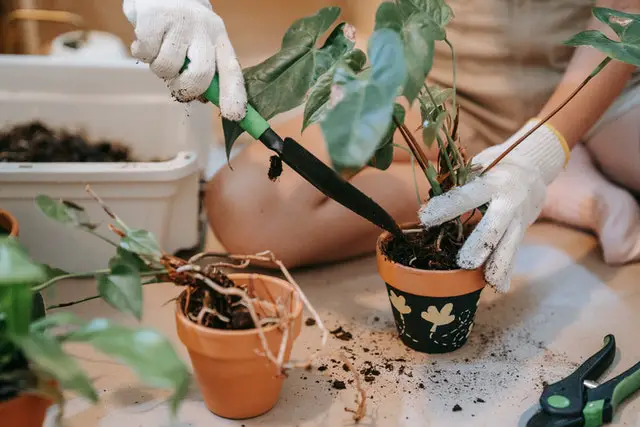Variegated plants can add interest and texture to any garden, making them a popular choice among gardeners and landscaping enthusiasts alike.
Do you know how to induce variegation in plants? When variegation occurs naturally, it’s usually the result of some sort of viral infection or there is a mutation in which the plant has trouble producing enough chlorophyll. It’s a complicated-sounding word that is fairly simple in its root cause.
Plant variegation doesn’t necessarily mean that they won’t produce vegetables or continue to propagate themselves. If it’s a viral infection, those are possibilities that often don’t bear out.
Understanding Variegation in Plants and Its Causes
Variegation refers to the presence of different colors or patterns in a plant’s leaves or other plant parts. While variegation can occur naturally through viral infections or genetic mutations, inducing variegation in plants is a more complex process.
Understanding the causes and mechanisms behind variegation is crucial for gardeners interested in exploring this unique feature in their plants.
How to Induce Variegation in Plants

There are a few ways to induce variegation in plants, including chemical mutagens, the use of radiation, constitutive and inducible promoters, transposing genes, and adding variegated plant tissues.
None of these methods are common or easy to do in your own home. In fact, far more plants are purchased already variegated than there are attempts to variegate existing plants at home. The problem is with the complex nature of the process, or any of the above-listed processes.
The common household is not going to have the necessary materials/tools or someone knowledgeable enough to harness ionizing radiation, identify different genes, transpose those genes, or safely use chemical mutagens.
That’s not to say that no households have these capabilities. There are certain people out there that work in industries that use this kind of technology and may have something at home that will do the trick.
For most people, however, proper variegation introduction in their houseplants is simply out of reach. There are ways to try and the simplest of those is the use of chemical mutagens, which is probably the least desirable way to induce variegation in your household plants.
Plus, the use of the necessary chemicals to induce variegation (Ethyl Methanesulfonate primarily) exposes the user to known carcinogens, so it must be handled with care. Also, chemically induced variegation is largely hit or miss.
Viral and Transposable Variegation Methods
Viral variegation occurs when a virus is introduced to the plant, either purposefully or naturally, which interrupts the plant’s ability to produce a uniform amount of chlorophyll. The problem with viral infections is that a virus is every bit as likely to kill the plant as it is to variegate it successfully.
Variegation that is induced by a virus is generally permanent. The problem is, it’s very unlikely that most people will get a hold of a plant virus and know how to properly spread it in the first place. So it’s not a viable solution for inducing variegation.
Transposable elements are a little easier in the way that flying to the moon is a little easier than flying to Mars. Transposable variegation is achieved by introducing a new genotype to an existing plant, something which is mostly done in the comfort of a lab.
You can’t achieve the same thing by grafting, which would be a much more reasonable action within most households. You have to take DNA, specifically DNA that you desire, and introduce that DNA into very specific chromosomes of the existing plant you want to variegate.
This interesting method was recently used by InnoTech in Alberta, Canada and you can see the results here. The overlying point, however, is that it was done by InnoTech, a place that has a fully funded science lab, working both with available materials and the lab equipment necessary to get it done.
Radiation-Induced Variegation

Radiation affects things at a cellular level, mostly by damaging those cells to one degree or another. The way that variegation is obtained through radiation is by taking root cuttings and placing them in the path of gamma rays or X-rays.
The problem is, it takes far more radiation than anyone can produce inside their own homes without gaining the attention of the kind of people you don’t want attention from. Outside of a lab, harnessing that level of radiation is not likely in a private household setting.
Chemical Variegation
Of the bunch, this is the one where most people can at least attempt, if not succeed, in reproducing. Ethyl Methanesulfonate (EMS) is used as the agent for variegation and it involves soaking viable seeds in an EMS solution for several hours (usually 6 to 12).
The problem with using EMS or any other kind of chemical variegation is that there is no real control mechanism. It either works or fails to work. When it fails, that means the seed is dead. Even if it does work, you might not be satisfied with the results.
Some home gardeners also try soaking viable seeds in herbicide solutions, such as Round-Up. Ethylene gas is also a method for inducing variegation but like radiation and genetic modification, it’s not something that most households are going to have.
There are also some suggestions out there that potent antibiotics will induce variegation but there probably needs to be more studies and information in that regard before it becomes a viable option at home.
Viral and Transposable Variegation: Complex Processes for Variegation Induction
Viral variegation occurs when a plant is infected with a virus that disrupts its ability to produce a uniform amount of chlorophyll. However, viral infections can be detrimental to plant health and survival, making them an unreliable method for inducing variegation.
Transposable variegation involves introducing new genetic material into an existing plant, a process typically performed in laboratory conditions. These methods require specialized knowledge and resources beyond what is feasible for most home gardeners.
How Do Most Homes Achieve Variegation?

By purchasing plants that are already variegated. It’s really the only viable way that most homes can achieve variegation. Of course, achieving it and maintaining it are two different things. Oftentimes, plants will try to essentially heal themselves and revert to their normal look.
How to Maintain Variegation
Most garden breeders purchase naturally or artificially variegated plants and propagate them. It’s big business once it gets rolling because variegated plants sell for a lot of money. To maintain it and propagate it you have to do a few things.
- Keep the plant maintained in indirect lighting
- Prune the plant of all 100% green leaves
- Prune leaves that look like they are eliminating the chlorophyll absence problem
- Avoid direct sunlight at all costs
Direct sunlight will hurt the plant rather than help it. Remember, variegated plants are plants that lack an adequate amount of chlorophyll to completely provide all of their eaves with a green appearance. This lack of chlorophyll is also a weakness.
When sunlight directly strikes a part of the plant that lacks chlorophyll, the plant lacks the necessary defense to avoid damage from the sun’s rays. Direct sunlight will kill those areas of the plant. If the plant survives, those areas will be replaced with chlorophyll-present leaves.
In other words, direct sunlight will effectively remove the achieved variegation if it doesn’t just kill the plant altogether. You also want to remove any green leaves or leaves that are almost entirely green.
These leaves will send signals back to the plant that they are much better at producing the necessary nutrients, such as sugars and starches. It’s natural for the plant to want to produce more of these kinds of leaves. You have to cut them off before they have that opportunity.
The remaining chlorophyll that exists in the leaves needs to be enough to feed the entire plant, which is why direct sunlight will either ruin the variegated look or kill enough leaves on the plant to cause the whole plant to die in the end.
Variegation Maintenance: Strategies for Preserving and Propagating Variegated Plants

For most home gardeners, purchasing already variegated plants is the most practical and reliable way to achieve variegation. To maintain and propagate variegated plants, specific care and pruning techniques are necessary.
These include keeping the plant in indirect lighting, pruning green leaves, and avoiding direct sunlight that can damage variegated areas. By preserving and propagating variegated plants, gardeners can continue to enjoy their unique aesthetic in successive generations
The Challenges of Inducing Variegation at Home
Inducing variegation in plants is not a common practice among home gardeners due to the complexity and specialized techniques involved. Methods such as chemical mutagens, radiation exposure, transposable elements, and genetic modification are typically carried out in laboratory settings with specialized equipment and expertise. These methods are not easily accessible or practical for most households. While chemical variegation is a possibility, it lacks a precise control mechanism and can be unpredictable in its outcomes.
See a previous post: Tomato Branches Curling Down
Bottom Line
Inducing variegation in plants is a complex process that often requires specialized techniques and resources beyond the capabilities of most home gardeners. While chemical mutagens and radiation exposure can be used to induce variegation, their implementation at home is challenging and potentially hazardous.
Viral and transposable variegation methods are even more complex, typically performed in controlled laboratory environments. As a result, the most practical approach for home gardeners is to purchase already variegated plants and propagate them to maintain the variegated aesthetic.
Preserving and propagating variegated plants require specific care, such as providing indirect lighting, pruning green leaves, and avoiding direct sunlight. By following these strategies, gardeners can successfully enjoy the unique beauty of variegated plants in their gardens.

Hey, I’m Lisa and I’ve been an avid gardener for over 30 years. I love writing, talking and living in the garden! Feel free to connect with me on my socials below

